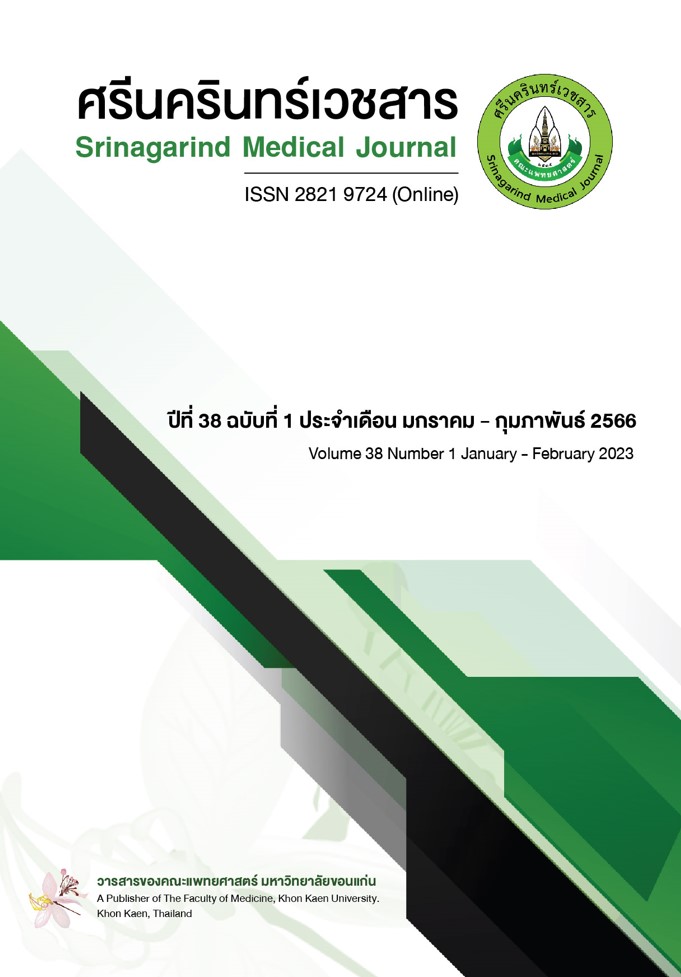Factor Associated with the Successful Prevention of Preterm Birth in Singleton Pregnant Women with a History of Spontaneous Preterm Birth or Incompetent Cervix
Keywords:
preterm birth, progestogen, cervical length, short cervix, incompetence cervix, cervical cerclageAbstract
Background and Objective: To study the factors associated with the successful prevention of preterm birth in singleton pregnant women with a history of spontaneous preterm birth or incompetent cervix.
Materials and methods: This prognostic research, retrospective cohort design recruited singleton pregnant women with a history of spontaneous preterm birth or incompetent cervix, who had antenatal care at Maharat Nakhon Ratchasima Hospital and delivered between October 2017 and September 2020. They received 17-alpha-hydroxy-progesterone caproate; (17-OHPC) 250 mg intramuscular injection weekly from 16 – 36 weeks gestation and measured cervical length biweekly from 16 – 24 weeks gestation. They received a cervical cerclage immediately if short cervix (less than 25 mm). By the way, the incompetent cervix group could receive a cervical cerclage immediately at 12 – 14 weeks gestation without the measurement of cervical length and continued 17-OHPC 250 mg intramuscular injection weekly from 16 – 36 weeks gestation. Age, body mass index (BMI), progestogen administration, transvaginal ultrasound cervical length (TVU-CL), cervical cerclage, and delivery status were recorded. Pregnant women with severe fetal anomalies, unknown delivery status, stillbirth, and indicated preterm birth were excluded from this study.
Results: We recruited 120 cases in the study, but 6 cases were excluded. 114 cases were remaining in this study. 78 cases had term delivery (68.4%). There was no difference in age, BMI, cervical length, and progestogen administration between the term and preterm delivery groups. When analyzed in the cervical cerclage group (18 cases): 12 cases had a term delivery (66.7%). They received a cervical cerclage at 17.4 ± 4.1 weeks gestation: the incompetent cervix group was done at 15.2 ± 3.2 weeks gestation and the short cervix group was done at 20.5 ± 3.1 weeks gestation. There was a statistical significance that the term delivery group received a cervical cerclage faster than the preterm group. (p=0.022)
Conclusion: There was no difference in age, BMI, and previous pregnancy history between the term and preterm delivery groups. However, we found a trend that may increase preterm birth such as the short cervix at the first time, delayed cervical cerclage, or previous preterm birth ≥ 2 times. Nevertheless, cervical cerclage before 16 weeks gestation without waiting to measure cervical length may increase the prevention of preterm birth.
References
World Health Organization. Preterm birth. 2018. [cited March 5, 2021]. Available from: www.who.int/news-room/fact-sheets/detail/preterm-birth.
Berghella V, Baxter JK, Hendrix NW. Cervical assessment by ultrasound for preventing preterm delivery. Cochrane Database Syst Rev 2009; (3):CD007235.
Chawanpaiboon S, Vogel JP, Moller AB, Lumbiganon P, Petzold M, Hogan D, et al. Global, regional, and national estimates of levels of preterm birth in 2014: a systematic review and modeling analysis. Lancet Glob Health 2019;7(1):e37-e46.
American College of Obstetricians and Gynecologists. ACOG Practice Bulletin No. 130: Prediction and prevention of preterm birth. Obstet Gynecol 2012; 120(4):964–73.
Rozenberg P, Gillet A, Ville Y. Transvaginal sonographic examination of the cervix in asymptomatic pregnant women: review of the literature. Ultrasound Obstet Gynecol 2002; 19(3):302–11.
Berghella V. Novel developments on cervical length screening and progesterone for preventing preterm birth. BJOG 2009; 116(2):182–7.
Mella MT, Berghella V. Prediction of preterm birth: cervical sonography. Semin Perinatol 2009; 33(5):317–24.
Society for Maternal-Fetal Medicine Publications Committee, with assistance of Vincenzo Berghella. Progesterone and preterm birth prevention: translating clinical trials data into clinical practice. Am J Obstet Gynecol 2012; 206(5):376–86.
Iams JD. Identification of candidates for progesterone: why, who, how, and when? Obstet Gynecol 2014; 123(6):1317-26.
Society for Maternal-Fetal Medicine Publications Committee. The choice of progestogen for the prevention of preterm birth in women with singleton pregnancy and prior preterm birth. Am J Obstet Gynecol 2017; 216(3):B11-3.
Owen J, Hankins G, Iams JD, et al. Multicenter randomized trial of cerclage for preterm birth prevention in high-risk women with shortened midtrimester cervical length. Am J Obstet Gynecol 2009; 201:375 e1-8.
Suhag A, Berghella V. Cervical cerclage. Clin Obstet Gynecol 2014; 57(3):557–67.
American College of Obstetricians and Gynecologists. ACOG Practice Bulletin No. 142: Cerclage for the management of cervical insufficiency. Obstet Gynecol 2014; 123:372-9.
Medley N, Vogel JP, Care A, Alfirevic Z. Interventions during pregnancy to prevent preterm birth: an overview of Cochrane systematic reviews. Cochrane Database Syst Rev 2018; 14;11:CD012505.
American College of Obstetricians and Gynecologists. ACOG Practice Bulletin No. 234: Prediction and prevention of spontaneous preterm birth. Obstet Gynecol 2021; 138(2):e65-90.
Downloads
Published
How to Cite
Issue
Section
License
Copyright (c) 2023 Srinagarind Medical Journal

This work is licensed under a Creative Commons Attribution-NonCommercial-NoDerivatives 4.0 International License.




